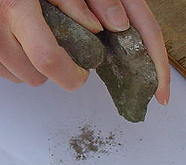SEO CONTAE SHLIGIGH
2002 A.D.
|
SEO CONTAE SHLIGIGH 2002 A.D. |
|
|
As rocks and stones move, they brush off each other and wear each other down. The little bits which come off are tiny "chips off the old block" and are called sand. (Save this page, edit the Date and the Laboratory entries, and print it out. Then do the experiment.) |
| Laboratory: Stokane National School
Date: 27th March 2002 Objective: To investigate how sand is formed Apparatus: Two stones, sheet of card. Method: Rub two stones together over a piece of card and little flakes of stone will drop off onto the card. |

Stones making sand |
|
|
|
|
We went to Encarta and read up on rocks, and how they were formed. The underlying rock in our area is limestone, and there are boulders of granite all over Co. Sligo. These came from Donegal during the last Great Ice Age. We have a local legend called the "Mermaid Rocks". We found some fossils also in our area. CONCLUSION |
|
|